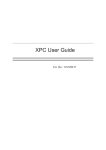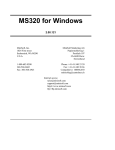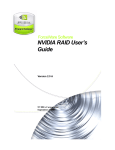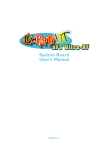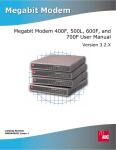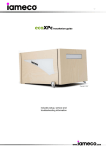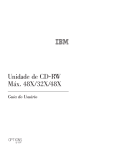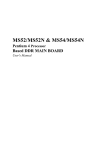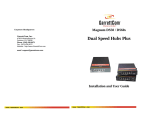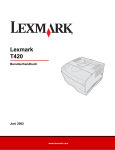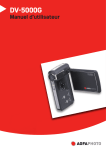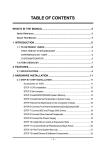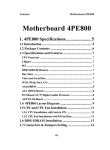Download Socket 939 AMD TM Athlon 64 Processor Based DDR Main
Transcript
FN95 Socket 939 AMD TM Athlon 64 Processor Based DDR Main Board User's Manual Shuttle® FN95 Socket 939 AMD AthlonTM 64 Processor Based DDR Mainboard Manual Version 1.0 Copyright Copyright© 2004 by Shuttle® Inc. All Rights Reserved. No part of this publication may be reproduced, transcribed, stored in a retrieval system, translated into any language, or transmitted in any form or by any means, electronic, mechanical, magnetic, optical, chemical, photocopying, manual, or otherwise, without prior written permission from Shuttle® Inc. Disclaimer Shuttle® Inc. shall not be liable for any incidental or consequential damages resulting from the performance or use of this product. This company makes no representations or warranties regarding the contents of this manual. Information in this manual has been carefully checked for reliability; however, no guarantee is given as to the correctness of the contents. In the interest of continued product improvement, this company reserves the right to revise the manual or include changes in the specifications of the product described within it at any time without notice and without obligation to notify any person of such revision or changes. The information contained in this manual is provided for general use by the customers. Trademarks Shuttle is a registered trademark of Shuttle Inc. AMD AthlonTM 64 is registered trademarks of AMD Corporation. nVIDIA is a registered trademark of nVIDIA Corporation. PS/2 is a registered trademark of IBM Corporation. AWARD is a registered trademark of Award Software Inc. Microsoft and Windows are registered trademarks of Microsoft Corporation. General Notice: Other brand and product names used herein are for identification purposes only and may be trademarks of their respective owners. M940 Statement of Shuttle Mainboard via the EMI Test Shuttle mainboards have been via the EMI test in terms of series of regulations: EN55022/ CISPR22/AS/NZS3548 Class B, EN55024 (1998/AS/NZS), EN4252.1 (1994), EN61000, ANSI C63.4 (1992), CFR47 Part 15 Subpart B, and CNS13438 (1997). The items tested are illustrated as follows: (A) Voltage: AC 110V/60HZ & AC 230V/50HZ (B) Tested Product Information: Product Name: PC Mainboard Status: Sample Model Name: FN95 S/N: N/A CPU: External Frequency: 200 MHz AMD AthlonTM 64 : 2900+, 3200+ Serial Port: one port with 9 pins Keyboard Port: one port with 6 pins Mouse Port: one port with 6 pins USB 2.0 Port: four ports with 4 pins respectively Parallel Port: one port with 25 pins 1394 Port: one port with 4 pins respectively 1394 Port: one port with 6 pins respectively LAN Port: one port with 8 pins (10Mbps/100Mbps/1000Mbps) Mic-In & Line-In & Earphone Ports: one port for each Coaxial Output Port: one port SPDIF In Port: one port DIMM Memory (optional): Kingston 256 MB *2 Power Cable: Detachable and Shielded (with a GND pin) Monitor: CRT Maximum Resolution: 1280 X 1024 V:60Hz All CPUs have completely been tested, and values offered by the worst EMI combination of CPU external frequency are listed as follows: Test Mode 1 External Frequency CPU 200MHz Athlon XP 3200+ (C) Remedy for the Tested Product & Its EMI Interference: Remedy: N/A EMI Interference: Crystal : 32.768 KHz(X2)/ 25 MHz(Y1)/ 25 MHz(X1)/ 24.576 MHz(X3)/ 24.576 MHz(X6) (D) Supported Host Peripherals: Host Peripheral Product Name Model Name #1 Case FN95 #2 Power Supply (240W) PC35I2402 #3 Western Digitel HDD (30 GB) WD300BB #4 MITSUMI FDD D353M3D #5 Panasonic DVD Player DVD-115 S/N FCC ID 3902B934 62007003 3892A807 (E) Notices for Assembling Computers: 1. Cases should be made of iron or other metal that has good electric conductivity. 2. Cylinders in a case should be made of metal, and as having a mainboard mounted in a case, make sure screws are all utilized and fastened on a mainboard. 3. An I/O shielding should be contacted with I/O metallic parts of a mainboard. 4. Cables should appropriately be arranged and fixed in a case. Follow instructions: Ø Leave IDE cables not crossed upon CPU and SDRAM; Ø Leave power cables minimum in length, and not crossed upon a mainboard; Ø Leave CPU fan cables minimum in length, and not near CPU; Ø Leave cables on panels and other spare cables tied in a computer case. 5. Make sure an EMI shielding attached to a case has properly been installed. 6. Make sure a 5.25" or 3.5" FDD and screws are fastened to an EMI shielding. 7. Make sure a case is closely in contact with EMI connected points. 8. Make sure there is no cleft in a case which is not deformed. 9. Make sure a PCI or AGP door is bound to a case. 10. Make sure cables of other devices (fans or some others) are fixed in a case. TABLE OF CONTENTS WHAT'S IN THE MANUAL .................................................................... 5 Quick Reference ............................................................................................... 5 About This Manual ........................................................................................... 5 1 INTRODUCTION ................................................................................ 6 1.1 TO DIFFERENT USERS ............................................................................. 6 FIRST-TIME DIY SYSTEM BUILDER............................................................ 6 EXPERIENCED DIY USER ........................................................................ 6 SYSTEM INTEGRATOR............................................................................... 6 1.2 ITEM CHECKLIST ....................................................................................... 7 2 FEATURES ........................................................................................ 8 2.1 SPECIFICATIONS ....................................................................................... 8 3 HARDWARE INSTALLATION .......................................................... 11 3.1 STEP BY STEP INSTALLATION ................................................................ 11 Accessories of FN95 ............................................................................. 11 STEP 1 Install the CPU .......................................................................... 12 STEP 2 Set Jumper ............................................................................... 13 STEP 3 Install DDR SDRAM System Memory........................................ 13 STEP 4 Install Peripherals in System Case ............................................ 14 STEP 5 Mount the Mainboard on the Computer Chassis ........................ 15 STEP 6 Connect Front Panel Header, Front Panel AUDIO/ USB/ 1394 Connector(JP16) ................................................................................... 16 STEP 7 Connect IDE, Floppy and Serial ATA Drives .............................. 17 STEP 8 Connect Other Internal Peripherals ............................................ 18 STEP 9 Install Add-on Cards in Expansion Slots .................................... 20 STEP 10 Connect the Power Supply Connectors ................................... 20 STEP 11 Connect External Peripherals to Back Panel ........................... 21 STEP 12 First Time System Boot Up ..................................................... 22 -1- STEP 13 Install Drivers & Software Components ................................... 23 3.2 JUMPER SETTINGS ................................................................................. 24 JUMPERS & CONNECTORS GUIDE .................................................... 25 Jumper Clear CMOS Setting (JP17) ................................................................. 27 Back-Panel Connectors COM1 Port Connector ........................................................................... 28 SPDIF-IN Connector .............................................................................. 28 1394 Port Connector ............................................................................. 28 PS/2 Mouse & PS/2 Keyboard Port Connectors .................................... 28 LAN Port Connector .............................................................................. 28 USB Port Connectors ............................................................................ 28 Coaxial Output Port Connector............................................................... 29 Line-In Port Connector ........................................................................... 29 Center/Bass-Out Port Connector ........................................................... 29 Rear-Out Port Connector ....................................................................... 29 Front-Out Port Connector ....................................................................... 29 Clear CMOS Button (SW1) .................................................................... 29 Front-Panel Connectors ATX Power On/Off Switch Connector (PWON) ....................................... 30 HDD LED Connector (HLED) ................................................................ 30 Green LED/ Power LED Connector (GLED/PWR_LED) ........................ 31 Hardware Reset Connector (RST) ......................................................... 31 Front Panel AUDIO/ USB/ 1394 Connector (JP16) ................................. 32 Internal Peripherals Connectors Enhanced IDE and Floppy Connectors................................................... 33 Serial ATA Connectors (ATA1/ATA2) ...................................................... 33 -2- Other Connectors ATX Power Supply Connectors (ATX1/CN5) .......................................... 34 Fan Connectors - FAN1/2/3 OFF when suspend .................................... 35 Wireless Keyboard/Mouse Connector (JP2) .......................................... 36 CD-IN Connector (CN7) (Black) ............................................................. 36 LINE_IN Connector (CN8) (White) .......................................................... 36 Mini CD_IN Connector (CN6) (White) .................................................... 36 Dual USB Header(JP3)/ USB Connectors(USB2, USB3)....................... 37 IrDA Header (JP5) ................................................................................. 37 SPDIF out Connector (CN4) .................................................................. 38 Printer Port Connector (J1) .................................................................... 38 3.3 SYSTEM MEMORY CONFIGURATION ..................................................... 39 4 SOFTWARE UTILITY ...................................................................... 40 4.1 Mainboard CD Overview ......................................................................... 40 4.2 Install Mainboard Software ...................................................................... 40 4.2.A Install DirectX9 Utility ............................................................................ 41 4.2.B Install nVIDIA Chipset Driver ................................................................ 41 4.2.C Install Marvell Giga LAN Driver............................................................. 42 4.2.D Install nVIDIA USB 2.0 Driver ................................................................ 42 4.3 View the User's Manual ............................................................................ 43 5 BIOS SETUP ................................................................................... 44 5.1 ENTER BIOS ............................................................................................. 44 5.2 THE MAIN MENU ...................................................................................... 45 STANDARD CMOS FEATURES ............................................................... 47 ADVANCED BIOS FEATURES ................................................................. 50 ADVANCED CHIPSET FEATURES .......................................................... 54 -3- INTEGRATED PERIPHERALS .................................................................. 57 POWER MANAGEMENT SETUP .............................................................. 60 PNP/PCI CONFIGURATION....................................................................... 63 PC HEALTH STATUS ................................................................................ 65 RATIO/VOLTAGE CONTROL ..................................................................... 67 LOAD FAIL-SAFE DEFAULTS................................................................... 68 LOAD OPTIMIZED DEFAULTS .................................................................. 68 SET PASSWORD ..................................................................................... 68 SAVE & EXIT SETUP ................................................................................ 69 EXIT WITHOUT SAVING ............................................................................ 69 -4- WHAT'S IN THE MANUAL Quick Reference Hardware Installation >> Step-by-Step ................................................ Page 11 Jumper Settings >> A Closer Look ....................................................... Page 24 Drivers/Software Utilities >> How to Install ......................................... Page 40 BIOS Setup >> How to Configure ......................................................... Page 44 About This Manual For First-Time DIY System Builder ......................................................... Page 6 For Experienced DIY User ...................................................................... Page 6 For System Integrator ............................................................................. Page 6 -5- 1 INTRODUCTION 1.1 To Different Users First-Time DIY System Builder Welcome to the DIY world! Building your own computer system is not as difficult as you may think. To make your first computer DIY experience successful, right from the start, we have designed the 3.1 Hardware Installation section in a step-by-step fashion for all the first-time DIY system builders. Prior to installation, we also suggest you to read the whole manual carefully to gain a complete understanding of your new Shuttle FN95 mainboard. Experienced DIY User Congratulate on your purchase of the Shuttle FN95 mainboard. You will find that installing your new Shuttle FN95 mainboard is just easy. Bundled with an array of onboard functions, the highly-integrated FN95 mainboard provides you with a total solution to build the most stable and reliable system. Refer to sections 3.2 Jumper Settings and Chapter 4 Drivers/Software Utilities to find out how to get the best out of your new mainboard. Chapter 5 BIOS Setup also contains the relevant information on how to tune up your system to achieve higher performance. System Integrator You have wisely chosen Shuttle FN95 to construct your system. Shuttle FN95 incorporates all the state-of-the-art technology of the nVIDIA nForce3 250 Ultra Single Chip for AMD TM Athlon64 939 CPU. It integrates the most advanced functions you can find to date in a compact Shuttle Form Factor board. -6- 1.2 Item Checklist Check all items with you FN95 mainboard to make sure nothing is missing. The complete package should include: COM1 OPT2 CN3 KB1 USB1 LAN1 A UDIO2 A UDIO1 SW1 - One piece of Shuttle FN95 Mainboard CN7 1 1 1 CN4 1 CN8 CN6 1 DIMM1 DIMM2 FAN1 J1 FLP1 1 AGP1 FAN2 ATA1 n VIDI A P CI1 R JP17 1 JP3 FAN3 USB USB3 USB2 1 JP5 IR S Y T K BATTER IUM STD LITHJAPAN 032 CR2 1 CN5 1 1 JP12 1 1 IDE1 1 - One piece of ATA133/100/66/33 Ribbon Cable 1 JP2 1 IDE2 JP16 ATX1 - One piece of Serial ATA Cable SERIAL VSO ATA - FN95 User's Manual - nVIDAI RAID User's Guide - One piece of Bundled CD-ROM with containing: Ø FN95 user's manual saved in PDF format Ø nVIDIA RAID User's Guide saved in PDF format Ø Install DirectX9 Utility Ø Install nVIDIA Chipset Driver Ø Install Marvell Giga LAN Driver Ø Install nVIDIA USB 2.0 Driver Ø Award Flashing Utility -7- 2 FEATURES FN95 mainboard is carefully designed for the demanding PC user who wants high performance and maximum intelligent features in a compact package. 2.1 Specifications - CPU Support AMD TM Athlon64 with 200MHz FSB colock on 939-pins SMT Socket. - Chipset nVIDIA nForce3 250 Ultra Single Chip for AMD TM Athlon64 939 CPU. Gigabit ETHERNET Controller Marvell 8001, support 10/100 /1000 Mbps operation rate. Supports Wakeon-Lan (WOL) function. Onboard 1394 VIA VT6307, support 400Mb/s, 200Mb/s, or100Mb/s data transfer rate. Compliants with 1394 OHCI specification revision V1.0 and V1.1 and provides 2 fully compliant ports. Onboard SATA Integrated SATA, support 2 Serial-ATA connectors (devices) with Raid 0/ 1/ 0+1/JBOD function. SATA Host controller spports Generation 1.5 Gb/s per channel for total of 3.0 Gb/s in each direction. - Jumperless CPU Configuration Soft-configuration FSB (The FSB speed is software configurable from 200MHz to 280MHz in the Advenced Chipset Features of BIOS setup program.) - On Board 5.1 Channel AC97 Audio Compliant with AC'97 2.2 specifications. 5.1 channel slot selectable DAC Output for multi-channel applications. - Versatile Memory Support 128-bit DDR SDRAM at 100/133/166/200 supports up to 2 GB. - AGP Expansion Slot Provides one 32-bit AGP slot which support 4X, 8X AGP device. - PCI Expansion Slots Provides one 32-bit PCI slot. - 8 USB 1.1/2.0 Complaint Interface Onboard -8- Ø 2 x USB connectors on back-panel, one set of dual USB port header on midboard. - I/O Interface Provides a variety of I/O interfaces: Ø 1 Floppy interface for 3.5-inch FDD with 720KB, 1.44MB, or 2.88MB format or for 5.25-inch FDD with 360K or 1.2MB format. Ø 1 COM1 Port. Ø 1 SPDIF IN Port. Ø 1 1394 Port. Ø 1 PS/2 Keyboard Port. Ø 1 PS/2 Mouse Port. Ø 1 10/100/1000 LAN Port. Ø 2 USB 1.1/2.0 Ports. Ø 1 Coaxial Port. Ø 1 Line-InPort. Ø 1 Center/Bass-Out port. Ø 1 Rear-Out port. Ø 1 Front-Out port. - PCI Bus Master IDE Controller Onboard Two Ultra DMA 133 Bus Master Dual-channel IDE ports provide support to a maximum of four IDE devices (one Master and one Slave per channel). The IDE Bus implements data transfer speeds of up to 133/100/66/33 MB/sec and also supports Enhanced PIO Modes. 80-pin Cable Backward Compatible Legacy ATAPI Devices, ATAPI IDE CDROM, CD-R, CD-RW, and LS-120 Supports. - ATX Power Supply Connector ATX power supply unit can connected to the onboard 20-pin standard ATX power connectors, supporting Suspend and Soft-On/Off by dual-function power button. One 4-pin 12V ATX power connector. - Advanced Configuration and Power Interface Features four power saving modes: S1 (Snoop), S3 (Suspend to RAM), S4 (Suspend to DISK), and S5 (Soft-Off). ACPI provides more efficient Energy Saving Features controlled by your operating system that supports OS Direct Power Management (OSPM) functionality. -9- - System BIOS Provides licensed Award BIOS V6.0 PG on 4Mb Flash core and supports Green PC, Desktop Management Interface (DMI). - Form Factor System board conforms to Small form factor ATX specification. Board dimension: 254mm X185mm. - Advanced Features Ø Low EMI - Built in spread spectrum and automatic clock shut-off of unused PCI/SDRAMS slots to reduce EMI. Ø Dual Function Power Button - The system can be in one of two states, one is Suspend mode and the other is Soft-Off mode. Pushing the power button for less than 4 seconds places the system into Suspend mode. When the power button is pressed for longer than 4 seconds, the system enters SoftOff mode. Ø Wake-on-LAN (WOL) - The onboard WOL connector can be attached to a network card that supports this function to wake up the system via LAN. Ø Modem Ring Power-On - The system can be powered on automatically by the activation of modem ringing. Ø CPU Host/SDRAM - This item allows users to adjust CPU Host Clock,and SDRAM in BIOS. - Intelligent Features Ø Voltage Monitoring - Monitors various voltages of key elements, such as the CPU, and other critical system voltage levels to ensure stable current passing through mainboard components. Ø Fan Status Monitoring - To prevent CPU from overheating, the CPU fan is monitored for RPM and failure. (CPU Cooling FAN with RPM sensor is required.) Ø Temperature Monitoring - This item allows users to make sure whether the CPU or system runs in a suitable temperature. - 10 - 3 HARDWARE INSTALLATION Before removing or installing any of these devices including CPU, DIMMs, Add-On Cards, Cables, please make sure to unplug the onboard power connector. This section outlines how to install and configure your mainboard. Refer to the following mainboard layout to help you to identify various jumpers, connectors, slots, and ports. Then follow these steps designed to guide you through a quick and correct installation of your system. 3.1 Step-by-Step Installation Accessories Of FN95 10/100/1000LAN & 1.1/2.0 USB 2.0 Connectors PS/2 Keyboard/Mouse Connectors Coaxial/Line-In Connectors CD-IN Connector-CN7 Center/Bass/Rear-Out/Front-Out Connectors Clear CMOS Button-SW1 SPDIF out Connector-CN4 LINE_IN Connector-CN8 SPDIF-IN Connector COM Connector COM1 OPT2 CN3 KB1 USB1 LAN1 AUDIO2 Mini CD-IN Connector-CN6 AUDIO1 SW1 FAN1 CN7 1 CN4 1 Printer Port Connector-J1 CN8 CN6 One PCI Slot 1 DIMM1 DIMM2 FAN1 J1 FLP1 1 AGP1 SOCKET 939 FAN2 ATX +12V Power Connector-CN5 ATX Power Connector-ATX1 PCI1 ATA1 Serial ATA Connectors -ATA1/ATA2 One AGP Slot n VIDIA nVIDIA nForce3 250 Chipset USB Connectors-USB2/3 R Clear CMOS-JP17 JP17 FAN3 1 JP3 FAN3 USB USB3 USB2 1 JP5 IR 1 CN5 1 JP12 1 1 IDE1 1 JP2 1 Front Panel Header-JP12 S RY T E K BATT IUM STD LITH JAPAN 032 2 CR 1 Dual USB Header-JP3 IrDA Header-JP5 FAN2 Two 184-pin DDRSDRAM DIMM Slots One Floppy Connector-FLP1 1 1 1 IDE2 JP16 ATX1 Two IDE Connectors-IDE1/IDE2 Wireless KB/MS Connector- JP2 Front Panel AUDIO/USB/1394 Connector- JP16 - 11 - Step 1 Install the CPU: 1. Locate the CPU ZIF (Zero Insertion Force) socket on the upper-right sector of your mainboard (between the back-panel connectors and the DIMM memory slots). 2. Pull the CPU ZIF socket lever slightly sideways away from the socket to unlock the lever, and then bring it to an upwardly vertical position. 3. Place your AMD AthlonTM 64 processor in the socket 939 CPU. Note that the CPU's edges have been purposely designed non-symmetrically to prevent from in serting the processor in the wrong direction. The following diagram demon strates the correct placement of the CPU in the ZIF socket. You can see that the Triangle Mark. A Triangle Mark A Triangle Mark AMD CPU Lever Lever 4. Slightly push the AMD Athlon 64 processor into the socket without applying exces sive force while making sure there is no gap between CPU and socket. Then lower the socket-lever all the way down to its horizontal position and lock it to secure the CPU in place. TM 5. The AMD AthlonTM 64 processor requires a set of heatsink/fan to ensure proper cooling of the processor. If heatsink/fan have not been already mounted on your CPU, you must purchase the heatsink/fan sepa-rately and have it installed. Plug the cable throught the heatsink/fan in the CPU fan power connector located nearby. Note that there are several types of CPU fan connectors. Normally, if your mainboard supports the hardware monitoring function, a 3-pin fan power connector should allow your system to detect the CPU fan's speed. The CPU fan can also run with a 2-pin fan power connector, however, detection of CPU fan's speed is not supported. Another type of CPU fan may feature a large 4-pin fan power connector, which does not support CPU fan's speed detection and must be directly connected to the system's power supply unit. Please refer to the following diagram. - 12 - Step 2 Set Jumper This mainboard is jumperless! The default jumper settings have been set for the common usage standard of this mainboard. Therefore, you do not need to reset the jumpers unless you require special adjustments as any of the following cases: 1. Clear CMOS For first-time DIY system builders, we recommend that you do not change the default jumper settings if you are not totally familiar with the mainboard configuration procedures. The factory-set default settings are tuned for optimum system performance. For the advanced users who wish to customize their system, section 3.2 Jumper Settings will provide detailed information on how to configure your mainboard manually. Step 3 Install DDR SDRAM System Memory To install memory, insert DDR SDRAM memory module(s) in DIMM slot(s). Note that DDR SDRAM modules are directional and will not go in the DIMM slots unless properly oriented. After the module is fully inserted into the DIMM slots, lift the clips of both sides of the DIMM slot to lock the module in place. Do not remove memory modules while DIMM LED is on. It might cause short or other unexpected damages due to the 2.5V stand by voltage. Remove memory modules only when AC Power cord is disconnected. DDR SDRAM DIMM Power LED DIMM Power LED (Green) - 13 - Step 4 Install Internal Peripherals in System Case Before you install and connect the mainboard into your system case, we recommend that you first assemble all the internal peripheral devices into the computer housing, including but not limited to the hard disk drive (IDE/ HDD), floppy disk drive (FDD), CD-ROM drive, and ATX power supply unit. This will greatly facilitate in making the connections to the mainboard described below. To install IDE & FDD drives, follow this procedure: 1. Set the required jumpers on each device according to the instructions provided by the manufacturer. (IDE devices, HDD, and CD-ROM, have to set jumpers to Master or Slave mode depending on whether you install more than one device of each kind.) 2. Connect IDE cable and FDD cable on the back-panel of the internal peripheral devices to the corresponding headers on board. Note that the cable should be oriented with its colored stripe (usually red or magenta) connected to pin#1 both on the mainboard IDE or FDD connector and on the device as well. 3. Connect an available power cable from your system power supply unit to the back-panel of each peripheral device. Note that the power cable is directional and cannot fit in if not properly positioned. - 14 - Step 5 Mount the Mainboard on the Computer Chassis 1. You may find that there are a lot of different mounting hole positions both on your computer chassis and on the mainboard. To choose correct mounting holes, the key point is to keep the back-panel of the mainboard in a close fit with your system case, as shown below. 2. After deciding on the proper mounting holes, position the studs between the frame of the chassis and the mainboard. The studs are used to fix the mainboard and to keep a certain distance between the system chassis and the mainboard, in order to avoid any electrical shorts between the board and the metal frame of the chassis. (If your computer case is already equipped with mounting studs, you will need to tighten screws to attach the mainboard.) Note : In most computer housings, you will be able to find 4 or more attachment points to install mounting studs and then fix the mainboard. If there aren enough matching holes, then make sure to install at least 4 mounting studs to ensure proper attachment of the mainboard. - 15 - Step 6 Connect Front Panel Header You can find there are several different cables already existing in the system case and originatinting from the computer's front-panel devices (HDD LED, Power LED,or Reset Switch devices etc.) These cables serve to connect the front-panel switches and LEDs connectors to the mainboard's front-panel connectors group, as shown below. JP12 - + - + 1 - + 2 HLED RST HLED - + + - - + 1. 2. 3. 4. GLED 3 PWON GLED/PLED 4 RST PWON 1 PLED Front Panel 1 JP12 ATX Soft Power On/Off (POWER ON) HDD-LED (HDD LED) Green-LED and Power-LED (GREEN LED/POWER LED) Hardware Reset Switch Button (RESET) Connect Front Panel AUDIO/ USB/ 1394 Connector(JP16) You can find there are several different cables already existing in the system case and originatinting from the computer's front-panel devices (AUDIO, USB, 1394a devices etc.). These cables serve to connect the AUDIO, USB, 1394a, connectors to the mainboard's front panel connectors group, as shown below. 2 50 1 49 Front Panel JP16 - 16 - Step 7 Connect IDE, Floppy and Serial ATA Drives 1. IDE cable connectors 1 1 IDE1 IDE2 FLP1 2. Floppy cable connector 1 3. Serial ATA connectors ATA2 ATA1 - 17 - Step 8 Connect Other Internal Peripherals 1. Wireless KB/MS Header (JP2) Wireless KB/MS 1 JP2 2. CD-IN(CN7), LINE-IN(CN8), MINI CD-IN(CN6) Connectors CD-IN CN7 1 Mini CD-IN LINE-IN CN8 1 CN6 1 3. IrDA Header (JP5) IrDA Header 1 JP5 - 18 - 4. DUAL USB Header (JP3) USB Connectors (USB2/USB3) JP3 1 1 1 USB3 USB2 5. SPDIF out Connector (CN4) CN4 1 6. Printer Port Connector (J1) J1 1 - 19 - Step 9 Install Add-on Cards in Expansion Slots 1. Accelerated Graphics Port (AGP) Card AGP proof LED: Serving as a smart burnout protection for the motherboard, this red LED lights up if you plug in any 3.3V AGP card into the AGP slot. When this LED is Lit, there is no way you can turn on the system power even if you press the power button. The red LED(AGP proof) is a smart protection from motherboard burn out caused by an incorrect AGP card. If you plug in any 3.3V AGP card into the 1.5V AGP slot, this LED lights up thus preventing the system to power up. This LED remains off if you plug in a 1.5V AGP card. AGP Proof LED (Red) 2. PCI Card Step 10 Connect the Power Supply Connectors 1. System power connectors (ATX1/CN5) ATX12V 1 CN5 1 ATX1 - 20 - ATXPWR Step 11 Connect External Peripherals to Back-Panel You are now ready to put the computer case back together and get on to the external peripherals connections to your system's back-panel. 1. 2. 3. 4. 5. 6. 7. 8. 9. 10. 11. 12. 13. COM Port SPDIF out Connector 1394 Port PS/2 Mouse Port PS/2 Keyboard Port 10/100/100 LAN Port USB 1.0/2.0 Port Coaxial Output Port Line-In Port 5-1 Channel Center/Bass Port 5-1 Channel Rear-Out Port 5-1 Channel Front-Out Port Clear CMOS Button 1 2 3 4 6 8 10 11 5 7 9 12 13 - 21 - Step 12 First Time System Boot Up To assure the completeness and correctness of your system installation, you may check the above installation steps once again before you boot up your system for the first time. 1. Insert a bootable system floppy disk (DOS 6.2x, Windows 95/98/NT, or others) which contains FDISK and FORMAT utilities into the FDD. 2. Turn on the system power. 3. First, you must use the FDISK utility to create a primary partition of the hard disk. You can also add an extended partition if your primary partition does not use all of the available hard disk space. If you choose to add an extended partition, you will have to create one or more logical partitions to occupy all the space available to the extended partition. The FDISK utility will assign a drive letter (i.e., C:, D:, E:,...) to each partition which will be shown in the FDISK program. After FDISK procedure, reboot your system by using the same system floppy disk. Note: DOS 6.2x and Windows 95A can only support up to 2.1GB of HDD partition. If you use the FDISK utility with one of the operating systems mentioned above, you can only install your HDD into partitions no larger than 2.1GB each. 4. Now, use the FORMAT utility to format all the partitions you've created. When formatting the primary partition (C:), make sure to use the FORMAT C: /S command. Note: FORMAT C: /S can transfer all the necessary system files into the primary partition of your hard disk. Then, your HDD will become a bootable drive. 5. Install all the necessary drivers for CD-ROM, Mouse, etc. 6. Setup the complete operating system according to your OS installation guide. - 22 - Step 13 Install Drivers & Software Components Please note that all the system utilities and drivers are designed for Win 9x/ 2000/ME/XP/NT operating systems only. Make sure your operating system is already installed before running the drivers installation CD-ROM programs. 1. Insert the FN95 bundled CD-ROM into your CD-ROM drive. The autorun program will display the drivers main installation window on screen. 2. Choose "Install DirectX9 Utility" and complete it. 3. Choose "Install nVIDIA Chipset Driver" and complete it. 4. Choose "Install Marvell Giga LAN Driver" and complete it. 5. Choose "Install nVIDIA USB 2.0 Driver" and complete it. 6. Exit from the autorun drivers installation program. ] Please refer to section Chapter 4 Software Utility to install driver. - 23 - 3.2 Jumper Settings Several hardware settings are made through the use of mini jumpers to connect jumper pins on the mainboard. Pin #1 could be located at any corner of each jumper, you just find the location with a white right angle which stands for pin 1#. There are several types of pin 1# shown as below: 3-pin and multi (>3) pin jumpers shown as following: Pin #1 to the left: Pin #1 on the top: Pin #1 to the right: Pin #1 on the bottom: Jumpers with two pins are shown as for Close [On] or for Open [Off]. To Short jumper pins, simply place a plastic mini jumpers over the desired pair of pins. Caution! 1. Do not remove the mainboard from its antistatic protective packaging until you are ready to install it. 2. Carefully hold the mainboard by its edges and avoid touching its components. When putting the mainboard down, place it on top of its original packaging film, on an even surface, and components side up. 3. Wear an antistatic wrist strap or take other suitable measures to prevent electrostatic discharge (ESD) whenever handling this equipment. - 24 - Jumpers & Connectors Guide Use the mainboard layout on page 11 to locate CPU socket, memory banks, expansion slots, jumpers and connectors on the mainboard during the installation. The following list will help you to identify jumpers, slots, and connectors along with their assigned functions: B13 B10~B12 E5 B8~B9 B6~B7 B4~B5 B3 B2 B1 E9 E6 E6 E4 D1 E2 E2 D2 E7 A1 E2 E7 E8 E1 C1~C4 D1 C5 E3 CPU/Memory/Expansion Slots Socket 939 : CPU Socket for AMD AthlonTM 64 DIMM1/2 : Two184-pin DIMM Slots for 64, 128, 256, 512 MB, and 1GB of 2.6V DDR SDRAM (The total installed memory does not exceed 2GB) PCI : One 32-bit PCI Expansion Slot AGP : One AGP Slot 4X/8X Slot - 25 - Jumper JP17 A1 B1 B2 B3 B4 B5 B6 B7 B8 B9 B10 B11 B12 B13 C1 C2 C3 C4 C5 D1 D1 D1 D2 E1 E2 E3 E4 E5 : Clear CMOS setting Back Panel Connectors COM1 : Serial port SPDIF IN : SPDIF IN Port 1394 : 1394 Port MS : PS/2 mouse port KB : PS/2 keyboard port LAN : 10/100/1000 LAN port USB : 2 X USB (2.0/1.1) (Universal Serial Bus) ports Coaxial : Coaxial Output port Line-In : Line-In port CENTER/BASS : 5-1 Channel Center/Bass Port Rear-Out : 5-1 Channel Rear-Out Port Front-Out : 5-1 Channel Front-Out Port SW1 : Clear CMOS Button Front Panel Connectors PWON : ATX power on/off momentary type switch HLED : IDE drive active LED GLED/PWR_LED : Green LED (ON when system stays in power saving mode) /System power LED RST : Hardware reset switch JP16 : Front Panel AUDIO/ USB/ 1394 Connector Internal Peripherals Connectors FLP1 : Floppy disk drive interface IDE1 : IDE primary interface (Dual-channel) IDE2 : IDE secondary interface (Dual-channel) ATA1/2 : Serial ATA 1/2 interfaces Other Connectors CN5/ATX1 : ATX power connectors FAN1, 2, 3 : Fan connectors JP2 : Wireless Keyboard and Mouse connector CN8 : Line_In connector CN7 : CD-IN connector - 26 - CN6 JP3/USB2/USB3 JP5 CN4 J1 E6 E7 E8 E9 E10 F : MINI CD-IN connector : DUAL USB Header/ USB Connectors : IrDA Header : SPDIF Out Connector : Printer Port Connector Jumper A1 Clear CMOS Setting (JP17) JP17 is used to clear CMOS data. Clearing CMOS will result in the permanently erasing previous system configuration settings and the restoring original (factory-set) system settings. 1 Pin 1-2 (Default) 1 Pin 2-3 (Clear CMOS) Clear CMOS 1 JP17 Step 1. Turn off the system power (PC-> Off). Step 2. Remove ATX Power cable from ATX Power connector. Step 3. Remove jumper cap from JP11 pins 1-2. Step 4. Place the jumper cap on JP11 pin 2-3 for a few seconds. Step 5. Return the jumper cap to pin 1-2. Step 6. Plug ATX Power cable into ATX Power connector. Step 7. Turn on the system power (PC-> On). - 27 - F Back-Panel Connectors B1 COM1 Port Connector This mainboard can accommodate one serial device on COM1. Attach a serial device cable to the DB9 serial port COM1 at the back-panel of your computer. B2 SPDIF-IN Connector SPDIF IN connector can accept digital audio data from Optic fiber. B3 1394 Port Connector This mainboard offers one 1394a ports on back-panel. Plug each device jack into an available 1394a connector. B4 B5 5 B6 SPDIF-IN Port 1394 Port PS/2 Mouse & PS/2 Keyboard Port Connectors Two 6-pin female PS/2 Mouse & Key board connectors are located on the rear panel of the mainboard. In a desktop computer, the PS/2 Mouse connector is situated on the top of the PS/2 Keyboard connector. In a tower computer, the PS/2 Mouse connector is located on the rightside of the PS/2 Keyboard connector. LAN Port Connector This mainboard can accommodate one device on LAN. Attach a RJ45 cable to the LAN port at the back-panel of your computer. B7 COM1 Port USB Port Connectors Two female connectors USB1/USB2 share the same USB (Universal Serial Bus) bracket at the rear panel of your mainboard. Plug each USB device jack into an available USB1/USB2 connector. - 28 - PS/2 Mouse Connector PS/2 Keyboard connector LAN Port USB Ports B8 Coaxial Output Port Connector Coaxial Output Port Coaxial Output connector can output digital audio data from coaxial cable. B9 Line-In Port Connector Line-In is a stereo line-level input port that accepts a 1/8-inch TRS stereo plug. It can be used as a source for digital sound recording, a source to be mixed with the output, or both. B10 Center/Bass-Out Port Connector Center/Bass-Out is a stereo output port through which the combined signal of all internal and external audio sources on the board is output. It can be connected to 1/8-inch TRS stereo headphones or to center/ bass amplified speakers. B11 Rear-Out Port Front-Out Port Connector Front-Out is a stereo output port through which the combined signal of all internal and external audio sources on the board is output. It can be connected to 1/8-inch TRS stereo headphones or to amplified speakers. B13 Center/Bass-Out Port Rear-Out Port Connector Rear-Out is a stereo line-level input port that accepts a 1/8-inch TRS stereo plug. It can be used as a source for digital sound recording, and a source to be mixed with the output, or both. B12 Line-In Port Front-Out Port Clear CMOS Button (SW1) This button is used to Clear CMOS data. You can clear CMOS without opening the chassis. It's very friendly button. - 29 - Clear CMOS Button F Front-Panel Connectors C1 ATX Power On/Off Switch Connector (PWON) The Power On/Off Switch is a momentary type switch used for turning on or off the system ATX power supply. Attach the connector cable from the Power Switch to the 2-pin (PWON) header on the mainboard. Front Panel RST HLED PWON GLED/PLED 1 JP12 Note : Please notice all the LED connectors are directional. If your chassis’s LED does not light up during running, please simply change to the opposite direction. C2 HDD LED Connector (HLED) Attach the connector cable from the IDE device LED to the 2-pin (HDD LED) header. The HDD LED lights up whenever an IDE device is active. Front Panel RST - + HLED PWON GLED/PLED - 30 - 1 JP12 C3 Green LED/ Power LED Connector (GLED/PWR_LED) This header is dual color LED function. Dual color LED function is defined by either Power LED or Green LED, the header can be in these states. The Green LED indicates that the system is currently in one of the power saving mode (Doze/Standby/Suspend). When the system resumes to normal operation mode, the Green LED will go off, power LED on. This Power LED will go off during power saving mode. Attach a 2-pin Green LED/Power LED cable to (GLED/PWR_LED) header. - + GLED - + 2 4 HLED PLED + - RST - + C4 PWON GLED/PLED 2 4 Front Panel 1 JP12 Hardware Reset Connector (RST) Attach the 2-pin hardware reset switch cable to the (RST) header. Pressing the reset switch causes the system to restart. Front Panel RST HLED PWON GLED/PLED - 31 - 1 JP12 Front Panel AUDIO/ USB/ 1394 Connector (JP16) C5 Port JP16 can be used to connect special device. 2 50 1 49 Front Panel JP16 Pin Assignments: 1=USBVCC 4=USBVCC 7=USBVCC 10=USBA13=USBB+ 16=GND 19=GND 22=TPB125=Front MIC 28=GND 31=Line_IN_R 34=GND 37=GND 40=Front_OUT_L 43=HDLED_PU 46=GLEDB 49=VCC 2=USBVCC 5=USBVCC 8=USBVCC 11=GND 14=USBB17=TPA1+ 20=GND 23=GND 26=FMIC_Power 29=Line_IN_L 32=SENSE1 35=Line_OUT_R 38=GND 41=GND 44=GLEDA 47=RST_SW 50=VCC - 32 - 3=USBVCC 6=USBVCC 9=USBA+ 12=GND 15=GND 18=TPA121=TPB1+ 24=GND 27=SENSE0 30=GND 33=GND 36=Front_OUT_R 39=Line_OUT_L 42=GND 45=HD_LED 48=PW_SW F Internal Peripherals Connectors D1 Enhanced IDE and Floppy Connectors The mainboard features two 40-pin dual-channel IDE device connectors (IDE1/ IDE2) providing support for up to four IDE devices, such as CD-ROM and Hard Disk Drives (H.D.D.). This mainboard also includes one 34-pin floppy disk controller (FDC) to accommodate the Floppy Disk Drive (FDD1). Moreover, this mainboard comes with one 80-pin ATA 133/100/66/33 ribbon cable to connect to IDE H.D.D. and one 34-pin ribbon cable for F.D.D. connection. FLP1 1 1 IDE1 IDE2 1 Important : Ribbon cables are directional, therefore, make sure to always connect with the red cable stripe on the same side as pin #1 of the IDE1/IDE2 or FDC connector on the mainboard. D2 Serial ATA Connectors (ATA1/ATA2) The Serial ATA is an evolutionary replacement for the Parallel ATA physical storage interface. Serial ATA is scalable and will allow future enhancements to the computing platform. The Serial ATA supports all ATA and ATAPI device, including CDs, DVDs, tape deATA2 ATA1 vices, high capacity removable devices, zip drivers, and CDRWs. The Serial ATA interface supports data transfer rates up to 150MB/s. - 33 - F Other Connectors E1 ATX Power Supply Connectors (ATX1/CN5) This motherboard uses 20-pin ATX power header (ATX1), and comes with the other one header (CN5). Please make sure you plug each in the right direction. It is essential to have these two power supply connectors plugged or your system won't boot up. ATX1 CN5 ATX12V 1 CN5 1 ATX1 ATXPWR A traditional ATX system remains in the power-off stage when AC power resumes from power failure. However, it is inconvenient for a network server or workstation if there is not an UPS to execute power-on. Thus, this motherboard supports an AC Power Auto Recovery function to solve this problem. You may enable the function, "PWRON After PWR-Fail," in the sub-menu of "Power Management Setup" within the BIOS setup program. Note 1: Note 2: Note 3: Note 4: The ATX power connector is directional and will not go in unless the guides match perfectly, making sure that pin#1 is properly positioned. Make sure the latch of the ATX power connector clicks into place to ensure a solid attachment. Your ATX power supply must be supplied to ACPI+5V standby power and at least 720mA compatible. Make sure your power supply have enough power for higher speed processor installed. - 34 - E2 Fan Connectors - FAN1/2/3 OFF when suspend The mainboard provides three onboard 12V cooling fan power connectors to support FAN1, FAN2 or FAN3 cooling fans. FAN1 FAN_CTRL FAN_SENSE FAN2 POWER 1 Ground FAN3 Note : Both cable wiring and type of plug may vary , which depends on the fan maker. Keep in mind that the red wire should always be connected to the +12V header and the black wire to the ground (GND) header. E3 Wireless Keyboard and Mouse Connector (JP2) Port JP2 can be used to connect wireless keyboard and mouse device. 4 mini Jumper must be setted on pin 5-6, 7-8, 9-10 and 11-12 when this header is not used. 11 9 Pin Assignments: 1=VCC 2=VCC 3=GND 4=KEY 5=MS_CLK 6=MS_CLK_IC 7=MS_DAT 8=MS_DAT_IC 9=KB_CLK 7 5 3 1 12 10 8 6 4 2 10=KB_CLK_IC 11=KB_DAT 12=KB_DAT_IC Wireless KB/MS 1 JP2 - 35 - E4 CD-IN Connector (CN7) (Black) Port CN7 is used to attach an audio connector cable from the CD-ROM drive. CD-IN 1 2 3 4 CN7 1 Pin Assignments: 1=CD-IN Left 3=Ground E5 CN7 2=Ground 4=CD-IN Right LINE_IN Connector (CN8) (White) Port CN8 (White) can be used to connect stereo audio inputs from CD-ROM, TV-tuner or MPEG card. CN8 1 2 3 4 LINE-IN CN8 1 Pin Assignments: 1=AUX-IN Left 3=Ground E6 2=Ground 4=AUX-IN Right Mini CD_IN Connector (CN6) (White) Port CN6 is used to attach an audio connector cable from the CD-ROM drive. 1 2 3 4 Mini CD-IN CN6 1 CN6 Pin Assignments: 1=Ground 2=CD-IN Right 3=Ground 4=CD-IN Left - 36 - E7 Dual USB Header(JP3)/ USB Connectors(USB2, USB3) The headers are used to connect the cable attached to USB connectors which are mounted on front panel or back panel. But the USB cable is optional at the time of purchase. USB2/3 JP3 1 2 3 4 5 E8 10 8 6 4 2 JP3 9 7 5 3 1 1 1 1 USB3 USB2 Pin Assignments (USB2/ USB3): Pin Assignments (JP3): 1=GND 1=VCC 2=VCC 2=GND 3=Data0- 4=Data1- 3=Data5+/ 4+ 5=Data0+ 6=Data1+ 4=Data5-/ 4- 7=Ground 8=Ground 5=VCC 9=Key 10=N/C IrDA Header (JP5) If you have an Infrared device, this mainboard can implement IR transfer function. To enable the IR transfer function, follow these steps: JP5 6 4 2 5 3 1 IrDA Header Pin Assignments: 1=N/C 2=KEY 3=VCC 4=GND 5=IRTX 6=IRRX 1 JP5 - 37 - E9 SPDIF out Connector (CN4) Port CN4 can be used to connect a special device. 3 2 1 CN4 CN4 1 Pin Assignments: 1=SPDIF-OUT 2=VCC 3=GND E10 Printer Port Connector (J1) One parallel port header is located at the rear panel of the mainboard. The header is used to connect the cable attached to a parallel connector. But the parallel cable and connector are optional at the time of purchase. J1 14 26 1 13 1 J1 Pin Assignments: 1=P_-STB 8=P_-PPD6 2=P_-PPD0 9=P_-PPD7 3=P_-PPD1 10=P_-ACK 4=P_-PPD2 11=P_BUSY 5=P_-PPD3 12=P_PE 6=P_-PPD4 13=P_SLCT 7=P_-PPD5 14=P_-AFD - 38 - 15=P_-ERR 16=P_-INIT 17=P_-SLIN 18=GND 19=GND 20=GND 21=GND 22=GND 23=GND 24=GND 25=GND 26=KEY 3.3 System Memory Configuration The FN95 mainboard has two 184-pin DIMM slots that allow you to install from 64MB up to 2GB of system memory. Each 184-pin DIMM (Dual In-line Memory Module) Slot can accommodate 64MB, 128MB, 256MB, 512MB, and 1GB of PC2100, PC2700 or PC3200 compliant 2.6V single or double side 64bit wide data path DDR SDRAM modules. Install Memory: Install memory in any or all of the slots and in any combination shown as follows. Devices Used on DIMMs Size Per CS 64 M-bit (2M x8-bits x4 bnaks) 64 Mbyte 64 M-bit (1M x16-bits x4 bnaks) 32 Mbyte 128 M-bit (4M x8-bits x4 bnaks) 128 Mbyte 128 M-bit (2M x16-bits x4 bnaks) 64 Mbyte 256 M-bit (8M x8-bits x4 bnaks) 256 Mbyte 256 M-bit (4M x16-bits x4 bnaks) 128 Mbyte 512 M-bit (16M x8-bits x4 bnaks) 512 Mbyte 512 M-bit (8M x16-bits x4 bnaks) 256 Mbyte 1 G-bit (32M x8-bits x4 bnaks) 1 G-bit (16M x16-bits x4 bnaks) 1 Gbyte 512 Mbyte Note: Total 2 DIMM capacities are up to 2GB max and 1GB per DIMM. Memory Configuration: DIMM1 DIMM2 64-Bit Single Side X 64-Bit Double Side X 128-Bit Single Side Single Side 128-Bit Double Side Double Side Note: Please plug the DIMM1 first. Upgrade Memory: You can easily upgrade the system memory by inserting additional DDR SDRAM modules in available DIMM slots. The total system memory is calculated by simply adding up the memory in all DIMM slots. After upgrade, the new system memory value will automatically be computed and displayed in the field " Standard CMOS Setup" of BIOS setup program. - 39 - 4 SOFTWARE UTILITY 4.1 Mainboard CD Overview Note : The CD contents attached in FN95 mainboard are subject to change without notice. To start your mainboard CD disc, just insert it into your CD-ROM drive and the CD AutoRun screen should appear. If the AutoRun screen does not appear, double click or run D:\Autorun.exe (assuming that your CD-ROM drive is drive D:) Navigation Bar Description: F Install Mainboard FN95 Series Driver - Installing DirectX9 Utility, nVIDIA Chipset, Marvell Giga LAN, nVIDIA USB 2.0 Driver. F Install Utility - Installing Acrobat Reader, Winflash Utility. F Manual - FN95 Manual and nVIDIA RAID User's Guide in PDF format. F Link to Shuttle Homepage - Link to shuttle website homepage. F Browse this CD - Allows you to see contents of this CD. F Quit - Close this CD. 4.2 Install Mainboard Software Insert the attached CD into your CD-ROM drive and the CD AutoRun screen should appear. If the AutoRun screen does not appear, double click on Autorun icon in My Computer to bring up Shuttle Mainboard Software Setup screen. Select using your pointing device (e.g. mouse) on the "Install Mainboard Software" bar to run into sub-menu. FN95 Software include: [4.2.A] Install DirectX9 Utility [4.2.B] Install nVIDIA Chipset Driver [4.2.C] Install Marvell Giga LAN Driver [4.2.D] Install nVIDIA USB 2.0 Driver - 40 - 4.2.A Install DirectX9 Utility Select using your pointing device (e.g. mouse) on the “Install DirectX9 Utility“ bar to install DirectX9. Once you made your selection, a Setup window run the installation automatically. When the copying files is done, make sure you reboot the system to take the installation effect. 4.2.B Install nVIDIA Chipset Driver Select using your pointing device (e.g. mouse) on the "Install nVIDIA Chipset Driver" bar to install chipset system driver. Once you made your selection, a Setup window run the installation automatically. When the copying files is done, make sure you reboot the system to take the installation effect. - 41 - 4.2.C Install Marvell Giga LAN Driver Select using your pointing device (e.g. mouse) on the "Install Marvell Giga LAN Driver" bar to install LAN driver. Once you made your selection, a Setup window run the installation automatically. When the copying files is done, make sure you reboot the system to take the installation effect. 4.2.D Install nVIDIA USB2.0 Driver Select using your pointing device (e.g. mouse) on the "Install nVIDIA USB2.0 Driver" bar to install USB2.0 driver. Once you made your selection, a Setup window run the installation automatically. When the copying files is done, make sure you reboot the system to take the installation effect. - 42 - 4.3 View the User's Manual Insert the attached CD into your CD-ROM drive and the CD AutoRun screen should appear. If the AutoRun screen does not appear, double click on AutoRun icon in My Computer to bring up Shuttle Mainboard Software Setup screen. Select using your pointing device (e.g. mouse) on the “Manual" bar. Then Online Information windows will appear on your screen. 1. Click on the “Install Acrobe Reader" bar if you need to install acrobe reader. 2. Click on "FN95 Manual" bar to view FN95 Series Mainboard User's Manual in PDF format. 3. Click on "nVIDIA RAID User's Guide" bar to view nVIDIA RAID User's Guide in PDF format. - 43 - 5 BIOS SETUP FN95 BIOS ROM has a built-in Setup program that allows users to modify the basic system configuration. This information is stored in battery-backed RAM so that it retains the Setup information even if the system power is turned off. The system BIOS is managing and executing a variety of hardware related functions in the system, including: System date and time Hardware execution sequence Power management functions Allocation of system resources 5.1 Enter the BIOS To enter the BIOS (Basic Input / Output System) utility, follow these steps: Step 1. Power on the computer, and the system will perform its POST (Power-On Self Test) routine checks. Step 2. Press <Del> key immediately, or at the following message: Press DEL to enter SETUP, or simultaneously press <Ctrl>, <Alt>, <Esc> keys Note 1. If you miss trains of words meationed in step2 (the message disappears before you can respond) and you still wish to enter BIOS Setup, restart the system and try again by turning the computer OFF and ON again or by pressing the <RESET> switch located at the computer's front-panel. You may also reboot by simultaneously pressing the <Ctrl>, <Alt>, <Del> keys. Note 2. If you do not press the keys in time and system does not boot, the screen will prompt an error message, and you will be given the following options: “Press F1 to Continue, DEL to Enter Setup” Step 3. As you enter the BIOS program, the CMOS Setup Utility will prompt you the Main Menu, as shown in the next section. - 44 - 5.2 The Main Menu Once you enter the AwardBIOS(tm) CMOS Setup Utility, the Main Menu will appear on the screen. The Main Menu allows you to select from several setup functions and two exit choices. Use the arrow keys to select among the items and press <Enter> to accept and enter the sub-menu. Note that a brief description of each highlighted selection appears at the bottom of the screen. Setup Items The main menu includes the following main setup categories. Recall that some systems may not include all entries. Standard CMOS Features Use this menu for basic system configuration. Advanced BIOS Features Use this menu to set the Advanced Features available on your system. Advanced Chipset Features Use this menu to change the values in the chipset registers and optimize your system's performance. Integrated Peripherals Use this menu to specify your settings for integrated peripherals. Power Management Setup Use this menu to specify your settings for power management. - 45 - PnP / PCI Configurations This entry appears if your system supports PnP / PCI. PC Health Status This entry shows the current system temperature, Voltage, and FAN speed. Ratio/Voltage Control Use this menu to specify your settings for ratio control. Load Fail-Safe Defaults Use this menu to load the BIOS default values for the minimal/stable performance of your system to operate. Load Optimized Defaults Use this menu to load the BIOS default values that are factory-set for optimal performance system operation. While Award has designed the custom BIOS to maximize performance, the factory has the right to change these defaults to meet users' needs. Set Supervisor / User Password Use this menu to change, set, or disable password. It allows you to limit access to the system and Setup, or only to Setup. Save & Exit Setup Save CMOS value changes in CMOS and exit from setup. Exit Without Saving Abandon all CMOS value changes and exit from setup. - 46 - @ Standard CMOS Features The items in Standard CMOS Setup Menu are divided into 10 categories. Each category includes no, one or more than one setup items. Use the arrow keys to highlight the item and then use the <PgUp> or <PgDn> keys to select the value you want in each item. Date <Month> <DD> <YYYY> Set the system date. Note that the 'Day' automatically changes when you set the date. Time <HH : MM : SS> The time is converted based on the 24-hour military-time clock. For example, 5 p.m. is 17:00:00. IDE Channel 0/1 Master/Slave Options are in its sub-menu. Press <Enter> to enter the sub-menu of detailed options. Drive A Select the type of floppy disk drive installed in your system. Ø The choice: None, 360K, 5.25 in, 1.2M, 5.25 in, 720K, 3.5 in, 1.44M, 3.5 in, or 2.88M, 3.5 in. Video Select the default video device. Ø The choice: EGA/VGA, CGA 40, CGA 80, or MONO. - 47 - Halt On Select the situation in which you want the BIOS to stop the POST process and notify you. Ø The choice: All Errors, No Errors, All, But Keyboard, All, But Diskette, or All, But Disk/Key. Base/Extended/Total Memory Theseitems are automatically detected by the system at start up time. These are display-only fields. You can't make change to these fields. ****************************************************** IDE Adapters The IDE adapters control the hard disk drive. Use a separate sub-menu to configure each hard disk drive. IDE HDD Auto-Detection Press <Enter> to auto-detect HDD on this channel. If detection is successful, it fills the remaining fields on this menu. Ø Press Enter IDE Channel0 Master Selecting 'manual' lets you set the remaining fields on this screen and select the type of fixed disk. "User Type" will let you select the number of cylinders, heads, etc., Note: PRECOMP=65535 means NONE ! Ø The choice: None, Auto, or Manual. Access Mode Choose the access mode for this hard disk. Ø The choice: CHS, LBA, Large, or Auto. Capacity Disk drive capacity (Approximated). Note that this size is usually slightly greater than the size of a formatted disk given by a disk checking program. Ø Auto-Display your disk drive size. The following options are selectable only if the 'IDE Primary Master' item is set to 'Manual' - 48 - Cylinder Set the number of cylinders for this hard disk. Ø Min = 0, Max = 65535 Head Set the number of read/write heads. Ø Min = 0, Max = 255 Precomp Warning: Setting a value of 65535 means no hard disk. Ø Min = 0, Max = 65535 Landing zone Set the Landing zone size. Ø Min = 0, Max = 65535 Sector Number of sector per track. Ø Min = 0, Max = 255 ****************************************************** - 49 - @ Advanced BIOS Features This section allows you to configure your system for basic operation. You have the opportunity to select the system's default speed, boot-up sequence, keyboard operation, shadowing, and security. Hard Disk Boot Priority This item allows you to select Hard Disk Book Device Priority. BIOS Write Protect The item allows you to enable/disable the Bios Write Protect. Ø The choice: Enabled or Disabled. Virus Warning Allows you to choose the VIRUS Warning feature for IDE Hard Disk boot sector protection. If this function is enables and someone attempts to write data into this area, BIOS will show a warning message on screen, and an alarm beep. Enabled Activates automatically when the system boots up, causing a warning message to appear when anything attempts to access the boot sector or hard disk partition table. Disabled No warning message will appear when anything attempts to access the boot sector or hard disk partition table. Ø The choice: Enabled or Disabled. - 50 - CPU Internal Cache All processors that can be installed in this mainboard use internal level 1 (L1) cache memory to improve performance. Leave this item at the default value for better performance. Ø The choice: Enabled or Disabled. External Cache Most processors that can be installed in this system use external level 2 (L2) cache memory to improve performance. Leave this item at the default value for better performance. Ø The choice: Enabled or Disabled. Quick Power On Self Test This item speeds up Power-On Self Test (POST) after you power on the computer. If it is set to enabled, BIOS will shorten or skip some check items during POST. Ø The choice: Enabled or Disabled. First/Second/Third Boot Device The BIOS attempts to load the operating system from the devices in the sequence selected in these items. Ø The Choice: Floppy, LS120, Hard Disk, CDROM, ZIP100, USB-FDD, USB-ZIP, USB-CDROM, Legacy LAN, or Disabled. Boot Other Device Select Your Boot Device Priority. Ø The choice: Enabled or Disabled. Boot Up Floppy Seek Seeks disk drives during boot-Up. Disabling speed boots up. Ø The choice: Enabled or Disabled. Boot Up NumLock Status Selects power-on state for NumLock. Ø The choice: Off or On. Gate A20 Option This entry allows you to select how the gate A20 is handled. The gate A20 is a device used for above 1MByte of address memory. Initially, the gate A20 was handled via a pin on the keyboard. Today, while a keyboard still provides this support, it is more common and much faster in setting to Fast for the system chipset to provide support for gate A20. Ø The choice: Normal, or Fast. - 51 - Typematic Rate Setting Keystrokes repeat at a rate determined by the keyboard controller. When this controller enabled, the typematic rate and typematic delay can be selected. Ø The choice: Enabled or Disabled. Typematic Rate (Chars/Sec) This item sets how many times the keystroke will be repented in a second when you hold the key down. Ø The choice: 6, 8, 10, 12, 15, 20, 24, or 30. Typematic Delay (Msec) Sets the delay time after the key is held down before it begins to repeat the keystroke. Ø The choice: 250, 500, 750, or 1000. Security Option Select whether the password is required every time the system boots or only when you enter setup. System The system will not boot and access to Setup will be denied if the correct password is not entered promptly. Setup The system will boot, but access to Setup will be denied if the correct password is not entered promptly. Ø The choice: System or Setup. Note: To disabled security, select PASSWORD SETTING at Main Menu, and then you will be asked to enter password. Do not type anything and just press <Enter>; it will disable security. Once the security is disabled, the system will boot, and you can enter Setup freely. APIC Mode Selects enable/disable IO APIC function Ø The choice: Enabled or Disabled. MPS Version Control For OS Selects the operating system multiprocessor support version. Ø The choice: 1.1 or 1.4 - 52 - OS Select For DRAM > 64MB Selects the operating system that is running with greater than 64MB of RAM in the system. Ø The choice: Non-OS2 or OS2. Small Logo(EPA) Show This item allows you to enable/disable the EPA Logo. Ø The choice: Enabled or Disabled. - 53 - @ Advanced Chipset Features This section allows you to configure the system based on the specific features of the installed chipset. This chipset manages bus speeds and access to system memory resources, such as DRAM and the external cache. It also coordinates communications between the conventional ISA bus and the PCI bus. It states that these items should never need to be altered. The default settings have been chosen because they provide the best operating conditions for your system. If you discovered that data was being lost while using your system, you might consider making any changes. DRAM Configuration Options are in its sub-menu. Press <Enter> to enter the sub-menu of detailed options. Max Memclock (Mhz) Places an artificial memory clock limit on the system. Memory is prevented from running faster than this frequency. Ø The Choice: Auto, 100, 133, or 166. 1T/2T Memory Timing This item selects the Memory Timing. Ø The Choice: Performance or Normal. CAS# latency When synchronous DRAM is installed, the number of clock cycles of CAS latency depends on the DRAM timing. Don't change this field from the default value specified by the system designer. Ø The Choice: CL=2.0, CL=2.5, CL=3.0 or Auto. - 54 - RAS# to CAS# delay (tRCD) This field lets you insert a timing delay between the CAS and RAS strobesignals, and you can use it when DRAM is written to , read from, or refreshed. Faster performance is gained in high speed, more stable performance, in low speed.. Ø The Choice: Auto, 2 Bus Clocks, 3 Bus Clocks, 4 Bus Clocks, 5 Bus Clocks, 6 Bus Clocks or 7 Bus Clocks. Min RAS# active time (tRAS) Places an artificial memory clock limit on the system. Memory is prevented from running faster than this frequency. Ø The Choice: Auto, 5 ~15 Bus Clocks. Row precharge Time (tRP) This field specifies the Row precharge Time. Precharge to Active or Auto-Refresh of the same bank. Typically 20-24 nsec. Ø The Choice: Auto, 2 ~6 Bus Clocks. CPU OverClock in MHz This item selects the CPU OverClock in MHz. Ø The choice: 200~280. AGP OverClock in MHz This item selects the AGP OverClock in MHz. Ø The choice: 66~100. AGP Aperture Size(MB) Select the size of Accelerated Graphics Port(AGP) aperture. The aperture is a portion of the PCI memory address range dedicated to graphics memory address space. Host cycles that hit the aperture range are forwarded to the AGP without any translaton. Ø The choice: 32M, 64M, 128M, 256M or 512M. AGP 3.0 Speed This item allows you to set the AGP 3.0 Speed. (With AGP 8x card) Ø The Choice: Always Auto. AGP 2.0 Speed This item allows you to set the AGP 2.0 Speed. (Without AGP 8x card) Ø The Choice: Auto, 1x, 1x2x or 1x2x4x. AGP Fast Write This item allows you to set the AGP Fast Write. Ø The Choice: Auto or Disabled. - 55 - AGP Sideband Address This item auto/disable the AGP sideband addressing capability for AGP cards. Ø The Choice: Auto or Disabled. Clock Spread Spectrum This item allows you to set the spread spectrum modulation. Ø The choice: Disabled or Enabled. HT Frequency This item allows you to set the HT Frequency. Ø The choice: 1x, 2x, 3x, 4x or 5x. Special I/O for PCI Card This item enable/disable the Special I/O for PCI Card. Ø The choice: Disabled or Enable. Base I/O Address This item allows you to set the Base I/O Address. Ø The Choice: 0000 ~ FFFF I/O Length This item allows you to set the I/O Length. Ø The choice: 1 Byte, 4 Byte, 8 Byte, 16 Byte, 32 Byte, 64 Byte, 128 Byte or 256 Byte. System BIOS Cacheable Select Enable allows caching of the system BIOS ROM at F000h-FFFFFh, resulting in better system performance. However, if any program is written to this memory area, a system error may result. Ø The Choice: Enabled or Disabled. - 56 - @ Integrated Peripherals Onboard IDE Device Options are in its sub-menu. Press <Enter> to enter the sub-menu of detailed options. RAID Function Setup This item allows you to setup the RAID Function. Ø The choice: Enter. OnChip IDE Channel0,1 The chipset contains a PCI IDE interface with support to two IDE channels. Select Enabled to activate the primary IDE interface. select Disabled to deactivate this interface. Ø The Choice: Enabled or Disabled. Primary/Secondary Master/Slave PIO The four IDE PIO (Programmed Input/Output) fields let you set a PIO mode (0-4) for each of the four IDE devices that the onboard IDE interface supports. Modes 0 through 4 provide successively increased performance. In Auto mode, the system automatically determines the best mode for each device. Ø The choice: Auto, Mode 0, Mode 1, Mode 2, Mode 3, or Mode 4. Primary/Secondary Master/Slave UDMA Ultra DMA/100 implementation is possible only if your IDE hard drive supports it and the operating environment includes a DMA driver (Windows 95 OSR2 or a third-party IDE bus master driver). If both of your hard drive and your system software support Ultra DMA/100, select Auto to enable BIOS support. Ø The choice: Auto or Disabled. IDE Prefetch Mode The onboard IDE drive interface support IDE prefetching for faster drive access. If you install a primary and /or secondary add-on IDE interface, set this field to Disabled if the interface does not support prefetching. Ø The Choice: Enabled or Disabled. - 57 - Serial-ATA 2(Internal PHY) This item allows you to enable/disable the Serial-ATA 2(Internal PHY). Ø The choice: Enabled or Disabled. IDE DMA transfer access This item allows you to enable/disable the IDE DMA transfer access. Ø The choice: Enabled or Disabled. IDE HDD Block Mode Block mode is also called block transfer, multiple commands, or multiple sector read/write. If your IDE hard drive supports block mode(most new drivers do), select Enabled for automatic detection of the optimal number of block read/write per sector the drive can support. Ø The Choice: Enable or Disabled. Onboard PCI Device Options are in its sub-menu. Press <Enter> to enter the sub-menu of detailed options. Init Display First This item is used to determine initial device when system power on. Ø The choice: AGP Slot or PCI Slot. OnChip USB This should be enabled if your system has a USB installed on the system board and you want to use it. Ø The choice: Desable, V1.1+V2.0, or V1.1. USB KB/Storeage Support Select Enabled if your system contains a Universal Serial Bus(USB) controller and you have a USB KB/Storeage. Ø The Choice: Enabled or Disabled. OnChip Audio This item allows you to control the onboard Audio. Ø The Choice: AUTO or Disabled. Onboard SuperIO Device Options are in its sub-menu. Press <Enter> to enter the sub-menu of detailed options. Onboard FDC Controller This item specifices onboard floopy disk drive controller. This setting allows you to connect your floopy disk drives to the onboard floopy - 58 - connector. Ø The Choice: Enable or Disabled. Onboard Serial Port1 This option is used to assign the I/O address and interrupt request(IRQ) for the onboard serial port1(COM1). Ø The Choice: Disabled, 3F8-IRQ4, 2F8-IRQ3, 3E8-IRQ4, 2E8-IRQ3, or Auto. Onboard Infrared Port This option is used to assign the I/O address and interrupt request(IRQ) for the onboard infrared port. Ø The Choice: Disabled, 3F8/IRQ4, 2F8/IRQ3, 3E8/IRQ4, 2E8/IRQ3, or Auto. UART Mode Select This item allows you to select IrDA infrared through COM2 port. Ø The Choice: IrDA, ASKIR, or SCR UR2 Duplex Mode This item allows you to select the IR half or full duplex function. Ø The Choice: Full, or Half. Onboard Parallel Port This item allows you to determine onboard parallel port controller I/O address and interrupt request(IRQ). Ø The Choice: Disabled, 378/IRQ7, 278/IRQ5, or 3BC/IRQ7. Parallel Port Mode Select an operating mode for the onboard parallel (printer) port. Select Normal, Compatible, or SPP unless you are certain your hardware and software both support one of the other available mode. Ø The Choice: SPP, EPP, ECP, or ECP+EPP. ECP Mode Use DMA When the onboard parallel is set to ECP mode, the parallel port can use DMA3 or DMA1. Ø The Choice: 1 or 3. - 59 - @ Power Management Setup The Power Management Setup allows you to configure your system to most effectively saving energy while operating in a manner consistent with your own style of computer use. ACPI Function This item allows Enable the Advanced Configuration and Power Management (ACPI) Ø The choice: Always Enabled. ACPI Suspend Type This item allows you to select sleep state when suspend. Ø The choice: S1(POS), S3(STR), or S1&S3. Power Management This category allows you to select the type (or degree) of power saving mode settings. Min Saving Minimum power management. Suspend Mode=15 min. Max Saving Maximum power management. Suspend Mode=1 min. User Define Allows you to set each mode individually. Suspend Mode= Disabled or 1 min ~15min. Ø The choice: User Define, Min Saving, or Max Saving. - 60 - Video Off Method This determines the manner in which the monitor is blanked. V/H SYNC+Blank This selection will cause the system to turn off the vertical and horizontal synchronization ports and write blanks to the video buffer. Blank Screen DPMS Supported This option only writes blanks to the video buffer. Initial display power management signaling. Ø The choice: V/H SYNC+Blank, Blank Screen, or DPMS Supported. HDD Power Down The IDE hard drive will spin down if it is not accessed within a specified length of time. Options are from 1 Min to 15 Min and Disable. Ø The choice: Disabled, 1 Min ~ 15 Min. HDD Down In Suspend The item allows you to enabled or disabled the HDD Down In Suspend. Ø The choice: Enabled, Disabled. Soft-Off By PBTN Pressing the power button for more than 4 seconds forces the system to enter the Soft-Off state when the system has " hung". Ø The choice: Delay 4 Sec, or Instant-Off. PWRON After PWR-Fail This item allows you to select power on function when power fail. Ø The choice: Former-Sts, Off or On. WOL(PME#) From Soft-Off If this item sets to Enable, the system power will be turned on when the LAN port receives an incoming signal. You have to connect the fax/ modem to the mainboard Wake On LAN connector for this feature to work. Ø The choice: Enabled, Disabled. WOR(RI#) From Soft-Off If this item is enable, it allows the system to resume from a software power down or power-saving mode whenever there is an incoming call to an installed fax/modem. You have to connector the fax/modem to the mainboard. Ø The choice: Enabled, Disabled. - 61 - USB Resume From S3 If you are using a USB keyboard, and the ACPI suspend type is set to S3, you can enable this item to allow a keystroke to wake up the system from power saving mod. Ø The choice: Enabled, Disabled. Power-On by Alarm When set to Enabled, the following three fields become available and you can set the month, date (day of the month), hour, minute and second to turn on your system. Ø The choice: Enabled, Disabled. Day of Month Alarm This item selects the alarm Day of Month. Ø The choice: 0~31. Time (hh : mm : ss) Alarm This item selects the alarm Time. [hh] Ø Key in a DEC number: Min=0, Max=23. [mm/ss] Ø Key in a DEC number: Min=0, Max=59. PS2 Keyboard Power ON When the POWER ON Function is set to PS2 Keyboard, use this item to set the PS2 keyboard combination that turns on the system. Ø The choice: Disabled, Password or Hot KEY. KB Power ON Password When the POWER ON Function is set to Password, use this item to set the password. Ø The choice: Enter. Hot Key Power ON When the POWER ON Function is set to Hot Key, use this item to set the hot key combination that turns on the system. Ø The choice: Ctrl-F1~F12 or Any key. PS2 Mouse Power ON When the POWER ON Function is set to PS2 Mouse, use this item to set the PS2 mouse combination that turns on the system. Ø The choice: Disabled or Enabled. - 62 - @ PnP/PCI Configurations This section describes the configuration of PCI bus system. PCI or Personal Computer Interconnection is a system which allows I/O devices to operate at the speed CPU itself keeps when CPU communicating with its own special components. This section covers some very technical items, and it is strongly recommended that only experienced users should make any changes to the default settings. Reset Configuration Data Normally, you leave this field Disabled. Select Enabled to reset Extended System Configuration Data (ESCD) when you exit from Setup if you have installed a new device or software and the system reconfiguration has caused such a serious conflict that the operating system can not boot. Ø The choice: Enabled or Disabled . Resource controlled By The Award Plug-and-Play BIOS has the capacity to automatically configure all of the boot and Plug-and-Play compatible devices. However, this capability means absolutely nothing unless you are using a Plug-and-Play operating system such as Windows 95. If you set this field to "manual" , choose specific resources by going into each of the sub-menu that follows this field (a sub-menu is proceeded by a ">"). Ø The choice: Auto(ESCD) or Manual. - 63 - IRQ Resources When resources are controlled manually, assign each system interrupt a type, depending on the type of device using the interrupt. IRQ3/4/5/7/9/10/11/12/14/15 assigned This item allows you to determine the IRQ assigned to the ISA bus and is not available to any PCI slot. Legacy ISA for devices is compliant with the original PC AT bus specification; PCI/ISA PnP for devices is compliant with the Plug-and-Play standard whether designed for PCI or ISA bus architecture. Ø The choice: PCI Device or Reserved. PCI/VGA Palette Snoop It determines whether the MPEG ISA/VESA VGA Cards can work with PCI/VGA or not. If you have MPEG ISA/VESA VGA Cards and PCI/ VGA Card worked, Enable this field. Otherwise, please Disable it. Ø The choice: Enabled or Disabled. - 64 - @ PC Health Status CPU Fan Speed Control Set the CPU Fan Speed. Ø The choice: Smart Fan, Ultra-Low, Low , Mid , or Full . Note : Before manually modifying the CPU fan setting, please make sure fan connectors are plug into the correct fan connector designations on the mainboard. CPU Temperature below 80 oC , cpu fan speed 1000 rpm. Ultra-Low CPU Temperature over 80 oC , cpu fan speed 3600 rpm. CPU Temperature below 80 oC , cpu fan speed 1600 rpm. Low CPU Temperature over 80 oC , cpu fan speed 3600 rpm. CPU Temperature below 80 oC , cpu fan speed 2400 rpm. Mid CPU Temperature over 80 oC , cpu fan speed 3600 rpm. Full CPU fan always 3600 rpm. - 65 - User Set CPU Fan Enabled you to choose one specific fan for further setting. Ø The choice: Fan1, Fan2, Fan3, Fan1 & Fan3. CPU Temp Tag Key in a DEC number. Min=30 Max=60 Ø The choice: 30~60 0C. CPU Voltage AGP Voltage +3.3V VIN +5V VIN +12V VIN -12V VIN RAM Voltage 5V SBVIN Voltage Battery System Temperature CPU Temperature Fan 1 Speed Fan 2 Speed Fan 3 Speed Warning : It is Strongly reco-mmended to disable CPU Fan Auto Guardian feature, if you wish to use other fan cooler, allowing the fan to run at its default speed. - 66 - @ Ratio/Voltage Control CPU Ratio Select This item allows you to set the CPU Ratio. Ø The choice: Auto, x4 800Mhz, x5 1000Mhz, x6 1200Mhz, x7 1400Mhz, x8 1600Mhz, x9 1800Mhz, x10 2000Mhz, x11 2200Mhz, x12 2400Mhz, x13 2600Mhz, x14 2800Mhz, x15 3000Mhz, x16 3200Mhz, x17 3400Mhz, x18 3600Mhz, x19 3800Mhz or x20 4000Mhz, CPU Voltage Select This item allows you to set the CPU Voltage. Ø The choice: 0.800V, 0.825V, 0.850V, 0.875V, 0.900V, 0.925V, 0.950V, 0.975V, 1.000V, 1.025V, 1.050V,1.075V, 1.100V, 1.125V, 1.150V, 1.175V, 1.200V, 1.225V, 1.250V, 1.275V, 1.300V, 1.325V, 1.350V, 1.375V, 1.400V, 1.425V, 1.450V, 1.475V, 1.500V, 1.525V, 1.550V, 1.600V, 1.650V, 1.700V or Auto. RAM Voltage Select This item allows you to set the RAM Voltage. Ø The choice: 2.70V, 2.80V, 2.90V or Auto. AGP Voltage Select This item allows you to set the AGP Voltage. Ø The choice: 1.60V, 1.70V, 1.80V or Auto. Chipset Voltage Select This item allows you to set the Chipset Voltage. Ø The choice: 1.70V, 1.80V, 1.90V or Auto. - 67 - @ Load Fail-Safe Defaults When you press <Enter> on this item, you will get a confirmation dialog box with a message similar to: Load Fail-Safe Defaults (Y/N) ? N Pressing 'Y' loads the BIOS default values for the most stable, minimal performance system operations. @ Load Optimized Defaults When you press <Enter> on this item, you will get a confirmation dialog box with a message similar to: Load Optimized Defaults (Y/N) ? N Pressing 'Y' loads the default values that are factory-set for optimal performance system operation. @ Set Supervisor/User Password Steps to set supervisor/user password are described as follows: - 68 - New Password Setting: 1. While pressing <Enter> to set a password, a dialog box appears to ask you enter a password. 2. Key in a new password. The password can not exceed eight characters. 3. System will request you to confirm the new password again. 4. When completed, new code takes effect. No Password Setting: If you want to disable the password, just press <Enter> as a password input is requested. If You Forget Password: If you forget the password, the only way to access the system is to clear the CMOS memory. Please refer to page 27 on clear CMOS setting. @ Save & Exit Setup Pressing <Enter> on this item asks for confirmation: SAVE to CMOS and EXIT (Y/N)? Y Pressing "Y" stores the selections made in the menus of CMOS - a special section of memory that stays on after you turn your system off. The next time you boot your computer, the BIOS configures your system according to the Setup selections stored in CMOS. After saving the values the system is restarted again. @ Exit Without Saving Pressing <Enter> on this item asks for confirmation: Quit Without Saving (Y/N)? N This allows you to exit from Setup without storing in CMOS any change. The previous selections remain in effect. This exits from the Setup utility and restarts your computer. - 69 -













































































